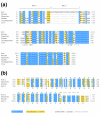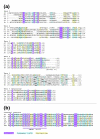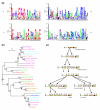Adaptive evolution of centromere proteins in plants and animals
- PMID: 15345035
- PMCID: PMC549713
- DOI: 10.1186/jbiol11
Adaptive evolution of centromere proteins in plants and animals
Abstract
Background: Centromeres represent the last frontiers of plant and animal genomics. Although they perform a conserved function in chromosome segregation, centromeres are typically composed of repetitive satellite sequences that are rapidly evolving. The nucleosomes of centromeres are characterized by a special H3-like histone (CenH3), which evolves rapidly and adaptively in Drosophila and Arabidopsis. Most plant, animal and fungal centromeres also bind a large protein, centromere protein C (CENP-C), that is characterized by a single 24 amino-acid motif (CENPC motif).
Results: Whereas we find no evidence that mammalian CenH3 (CENP-A) has been evolving adaptively, mammalian CENP-C proteins contain adaptively evolving regions that overlap with regions of DNA-binding activity. In plants we find that CENP-C proteins have complex duplicated regions, with conserved amino and carboxyl termini that are dissimilar in sequence to their counterparts in animals and fungi. Comparisons of Cenpc genes from Arabidopsis species and from grasses revealed multiple regions that are under positive selection, including duplicated exons in some grasses. In contrast to plants and animals, yeast CENP-C (Mif2p) is under negative selection.
Conclusions: CENP-Cs in all plant and animal lineages examined have regions that are rapidly and adaptively evolving. To explain these remarkable evolutionary features for a single-copy gene that is needed at every mitosis, we propose that CENP-Cs, like some CenH3s, suppress meiotic drive of centromeres during female meiosis. This process can account for the rapid evolution and the complexity of centromeric DNA in plants and animals as compared to fungi.
Figures






Similar articles
-
Centromeric localization of αKNL2 and CENP-C proteins in plants depends on their centromere-targeting domain and DNA-binding regions.Nucleic Acids Res. 2025 Feb 8;53(4):gkae1242. doi: 10.1093/nar/gkae1242. Nucleic Acids Res. 2025. PMID: 39718987 Free PMC article.
-
Adaptive evolution of the histone fold domain in centromeric histones.Mol Biol Evol. 2004 Sep;21(9):1712-8. doi: 10.1093/molbev/msh179. Epub 2004 Jun 2. Mol Biol Evol. 2004. PMID: 15175412
-
Naturally occurring differences in CENH3 affect chromosome segregation in zygotic mitosis of hybrids.PLoS Genet. 2015 Jan 26;11(1):e1004970. doi: 10.1371/journal.pgen.1004970. eCollection 2015 Jan. PLoS Genet. 2015. PMID: 25622028 Free PMC article.
-
[Advances in research of the structure and function of plant centromeres].Yi Chuan. 2006 Dec;28(12):1597-606. doi: 10.1360/yc-006-1597. Yi Chuan. 2006. PMID: 17138549 Review. Chinese.
-
Centromeres Drive a Hard Bargain.Trends Genet. 2017 Feb;33(2):101-117. doi: 10.1016/j.tig.2016.12.001. Epub 2017 Jan 7. Trends Genet. 2017. PMID: 28069312 Free PMC article. Review.
Cited by
-
Centromeres of filamentous fungi.Chromosome Res. 2012 Jul;20(5):635-56. doi: 10.1007/s10577-012-9290-3. Chromosome Res. 2012. PMID: 22752455 Free PMC article. Review.
-
Intrinsic elasticity of nucleosomes is encoded by histone variants and calibrated by their binding partners.Proc Natl Acad Sci U S A. 2019 Nov 26;116(48):24066-24074. doi: 10.1073/pnas.1911880116. Epub 2019 Nov 11. Proc Natl Acad Sci U S A. 2019. PMID: 31712435 Free PMC article.
-
Who's driving the centromere?J Biol. 2004;3(4):17. doi: 10.1186/jbiol15. Epub 2004 Oct 11. J Biol. 2004. PMID: 15485584 Free PMC article. Review.
-
Identification and diversity of functional centromere satellites in the wild rice species Oryza brachyantha.Chromosome Res. 2013 Dec;21(8):725-37. doi: 10.1007/s10577-013-9374-8. Chromosome Res. 2013. PMID: 24077888
-
Expressed Centromere Specific Histone 3 (CENH3) Variants in Cultivated Triploid and Wild Diploid Bananas (Musa spp.).Front Plant Sci. 2017 Jun 29;8:1034. doi: 10.3389/fpls.2017.01034. eCollection 2017. Front Plant Sci. 2017. PMID: 28706522 Free PMC article.
References
-
- Lohe A, Roberts P. Evolution of satellite DNA sequences in Drosophila. In: Verma RS, editor. In Heterochromatin, Molecular and Structural Aspects. Cambridge: Cambridge University Press; 1988. pp. 148–186.
MeSH terms
Substances
LinkOut - more resources
Full Text Sources
Other Literature Sources
Molecular Biology Databases

